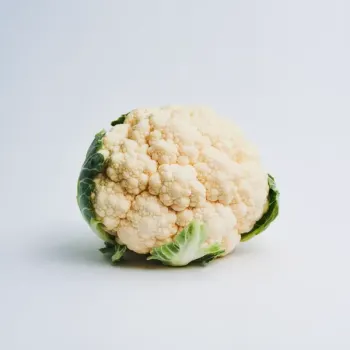
Substitutes for cauliflower in cooking include broccoli and Brussels sprouts for roasted dishes, potatoes and turnips for soups and stews, zucchini and spaghetti squash for gluten-free recipes, broccoli rice and shredded cabbage for low-carb alternatives, and portobello mushroom and tempeh for vegan meat substitutes.
Broccoli is a close relative to cauliflower and can be roasted to provide a similar texture and flavor. It works well as a substitute in most dishes, offering a slightly stronger taste. Roast until the edges are crispy for best results. Use a 1:1 ratio. Popular brands include Green Giant and Mann's.
Brussels sprouts can be halved and roasted to give a crunchy and nutty flavor, making them a great substitute. They have a bolder taste and provide a similar hearty bite. Roast with olive oil until golden brown. Use a 1:1 ratio. Brands like Ocean Mist and Pero Family Farms are recommended.
Potatoes can be cubed and added to soups and stews as a substitute for cauliflower. They have a comforting texture and absorb flavors well. Use a 1:1 ratio by volume. Expect a different flavor profile and thicker consistency. Brands like Idahoan and Yukon Gold are well-known.
Turnips can be diced and used as a lower-carb alternative to cauliflower in soups and stews. They offer a slightly tangy flavor and hold their shape well when cooked. Use a 1:1 ratio by volume. Brands such as Melissa's provide quality turnips.
Zucchini can be spiralized or chopped as a gluten-free alternative to cauliflower. It's lighter in texture and has a higher water content, so it may need to be drained or patted dry. Use a 1:1 ratio by volume. Expect a more delicate texture. Brands like Cal-Organic offer organic options.
Spaghetti squash can be roasted and shredded to create a gluten-free base for meals, similar to cauliflower rice or mash. It has a slightly sweet taste and stringy texture. Use a 1:1 ratio by volume after cooking. Brands like Del Monte supply fresh spaghetti squash.
Broccoli rice is made by pulsing broccoli florets in a food processor until they resemble grains of rice. It serves as a nutrient-dense, low-carb substitute for cauliflower rice. Use a 1:1 ratio. Expect a slightly more pronounced flavor. Brands like Green Giant offer pre-riced broccoli.
Shredded cabbage can replace cauliflower in slaws or as a cooked low-carb option. It has a crunchier texture and a peppery flavor. Use it in a 1:1 ratio for both raw and cooked preparations. Brands such as Taylor Farms provide pre-shredded options.
Portobello mushrooms have a meaty texture that makes them a great stand-in for cauliflower steaks. They absorb flavors well and can be grilled or baked. Use a 1:1 ratio by size. Expect a more umami flavor. Brands like Monterey Mushrooms are commonly found.
Tempeh, made from fermented soybeans, can be crumbled and used as a high-protein alternative to cauliflower in dishes like tacos. It has a nutty flavor and firm texture. Use a 1:1 ratio by weight. Brands like Lightlife and Tofurky are popular choices.

Your ultimate Recipe Box, Meal Planner, and Cooking Class all in one
| Recipe Category | Substitutes |
|---|---|
| Roasted Dishes | Broccoli, Brussels Sprouts |
| Soups and Stews | Potatoes, Turnips |
| Gluten-Free Recipes | Zucchini, Spaghetti Squash |
| Low-Carb Alternatives | Broccoli Rice, Shredded Cabbage |
| Vegan Meat Substitutes | Portobello Mushroom, Tempeh |
Cauliflower is a beloved ingredient for its adaptability in various dishes, but the substitutes listed above can offer similar benefits and open up new flavors and textures in your cooking. Whether you're accommodating dietary needs or simply experimenting, these alternatives will help you maintain the spirit of intuitive cooking.